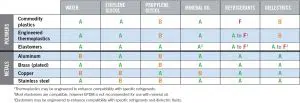Power densities in electronic subsystems continue to increase, driving demand for more extreme cooling power alternatives that increasingly include liquid cooling as a viable candidate. To optimize thermal management efficiency, sustainability and reliability, designers of systems that use liquid cooling are exploring innovative combinations of component materials, including advanced thermoplastics, specialized elastomers, metal alloys and engineered fluids.
Whether designing a closed-loop, single-phase immersion, two-phase immersion or direct-to-chip cooling system, component material compatibility is critical to performance. This article provides general guidance regarding selecting the right ingredients for a liquid cooling solution.
Think Holistically When Selecting Components
A variety of subsystems and components make up the architecture that is critical to the successful and reliable operation of any cooling system.
Each system component has the potential to interact with other component materials. Therefore, materials interactions and dependencies warrant detailed analysis during design and specification.

Coolants are of particular interest, not only as the primary conduit of thermal transfer, but because they are in contact with all wetted materials within a particular cooling system, as indicated in Figure 1. Some fluids may promote corrosion or biofouling in the presence of certain materials, creating the potential for flow blockage or failure of the cooling system. It is essential to understand what all the materials are and the interactions that they might have. Specifically, when assessing concerns related chemical compatibility, potential permeation and diffusive losses, it is important to identify critical points of connection – such as tubing junctions, manifold ports, and quick disconnect fittings – and evaluate each one for risks to reliability and performance.
Overall, when it comes to material selection, one must think holistically. This includes accounting for all system components and considering the potential effects of the environment, working fluid, temperature, pressure, and mechanical loading, which might adversely impact performance.
This article will discuss liquids commonly used in liquid cooling applications and present an overview of the materials of construction. Finally, we’ll provide guidance regarding the potential compatibility of these fluids and materials when used together.
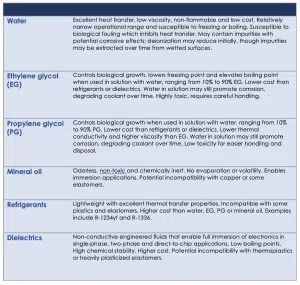
Tapping Coolant Alternatives
Obviously, choosing a coolant is a focal point when designing a liquid cooling system. From a compatibility standpoint, it is important to recognize that the fluid links virtually every component as it circulates through the liquid cooling system. Table 1 provides a brief overview of a number of fluids typically used in cooling electronics.
The first step in selecting a coolant is to consider operating and storage temperatures. Fluid properties must be appropriate to the application environment, such as a boiling point that satisfies the thermal load and thermal efficiency needed without exceeding the critical heat flux. Fluids must also have suitable low temperature characteristics during storage and shipping, environmental exposures, particularly engineered dielectrics such as fluorochemicals, as well as refrigerants. It is often necessary to understand the environmental impact of the fluid throughout the life cycle – how it’s manufactured, the potential impact of it leaching into the facility or atmosphere during use, and end-of-life fluid reclamation requirements.
When selecting fluids, the ozone depletion and global warming potentials need to be considered, particularly for refrigerants and dielectrics. Over the last decade or so, the World Health Organization guidelines have increased emphasis on these parameters, prompting the development of greener alternatives, such as 3M Novec™, HFE coolant, and more environmentally friendly, fourth generation hydrofluoroolefin refrigerants like R-1234 or R-1336.
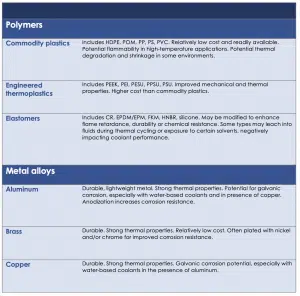
In addition to thermal stability and chemical compatibilities, properties such as coolant toxicity, flammability, cleanliness requirements, environmental impact, and cost should be considered. And of course, when comparing coolant types and options, all materials that the fluid may come in contact with throughout the system should be evaluated.
Sizing Up Materials of Construction
Electronics cooling system components are, in general, comprised of three types of polymers – commodity plastics, engineered thermoplastics, and elastomers – and four types of metal alloys – aluminum, brass, copper and stainless steel. Table 2 provides a high-level comparison of liquid cooling system component materials of construction.
Polymer Strengths
Polymer properties can vary widely based on processing, additives, fillers, and where they are on the spectrum, from commodity to ultra-high-performance thermoplastics and elastomers.
Polymers can replace metal in many areas, and often provide additional benefits. For example, engineered thermoplastics like PPSU and PEEK can meet higher thermal, chemical and mechanical requirements compared to metals while providing the added benefits of reduced weight and better corrosion resistance at a potentially lower cost.
Engineered thermoplastics can be an excellent choice, especially when considering effects of weight, chemical compatibility, and price over metal counterparts. When specifying thermoplastic materials look for mechanical strength, chemical compatibility, and thermal stability characteristics.
Polymer Limitations
Polymers, in particular commodity plastics and some thermoplastics, may present issues in certain applications.
Given the emerging prevalence of warm-water cooling systems, polymer resistance to hydrolysis has become an important factor. Polymers with hydrolyzable links may be at risk for severe property degradation in hot water environments. The same risk may apply for fluorochemicals in contact with fluorinated polymers. As we know, like dissolves like, and there could be a risk of solubility of certain plasticizers or additives into the coolant fluid.
Since flammability may also be a concern with some polymers, designs should include inherently non-flammable materials, specifically non halogenated thermoplastics. Long-term exposure to a wide range of temperatures is certainly a key consideration for material selection in cooling systems.
Additional risks associated with thermoplastics include chemical attacks and crazing, cracking, discoloration, and, as previously mentioned, extraction or leaching into the coolant. Fluid absorption, swelling and certainly thermal aging and degradation effects over time and also mechanical loading and an internal pressure stresses are potential threats to integrity as well.
Elastomers
Elastomers can be engineered to meet a wide range of performance requirements.
Elastomers are polymers that have the property of viscoelasticity – they are rubbery and flexible – and are primarily used in components for fluid transport, such as tubing and hose, as well as sealing components such as O-rings and gaskets. To understand how elastomers tend to behave, we can look at how they’re made.
Vulcanization, or the process of curing, creates permanent cross-links in long polymer chains in elastomers. These chains ensure that when stresses are loaded and unloaded, the elastomeric component will return to its original position. In the case of an O-ring and a quick disconnect, for example, an elastomer will maintain its seal.
At a high level, specifying elastomers for use in a liquid cooling application requires detailed analysis and evaluation with the selected unique coolant to ensure compatibility and long-term reliability.
For discussion purposes, some common material compound categories that might be seen in these applications can be identified as hydrogenated nitrile, ethylene-propylene or EPDM, and chloroprene. HNBR has great chemical resistance, excellent mechanical properties, including tensile strength, tear modulus to the wide temperature range and can be compounded for excellent resistance for high pressure applications. EPDM has excellent hot water and steam resistance characteristics. However, because it has lower resistance to hydrocarbon, it is not well suited for any refrigerant type application.
Chloroprene, which is commonly known as neoprene, is very resistant to many chlorofluorocarbons or CFCs that are used as refrigerant. It has low cost but moderate chemical resistance and limited temperature resistance.
Some additional things to consider when specifying elastomers are to consider the hardness (the durometer), the thermal robustness under both continuous and intermittent exposures, and certainly the compounding as it relates directly to chemical compatibility.
Metal Alloys
Compared to commodity plastic polymers, metal components in liquid cooling systems are generally more stable, more durable and have a perception of longer-term reliability. Metal components also tend to be heavier and can be more expensive. In many applications, the enhanced performance characteristics of metals warrants the additional investment. In other applications, the right polymer may actually provide the best solution.
When considering metal alloys for use in systems, one should account for mechanical strength, surface treatment, and cleanliness. While many refrigerants and engineered fluids are low- to non-corrosive to metals, designers still must consider the operating environment with regard to corrosion.
Putting it All Together: Chemical Compatibility
With a foundational understanding of the fluids, plastics and metals that might be employed in a given liquid cooling application, one can assess potential chemical compatibility of system components, based on their make-up, to ensure reliable, long term operation.
While polymers and metals can be effective in any combination when appropriately specified, it is critical to distinguish wetted materials of construction from structural materials. Wetted materials include all components that are directly exposed to the coolant and therefore, are indirectly exposed to one another. Structural materials are not exposed to coolant during normal operation. Creating a list of wetted and structural materials early in the design cycle can help avoid complications down the road.
A given component might potentially be built of a combination of polymers and metals. Thus, it is important to distinguish the wetted materials from structural materials within a given component. For example, a quick disconnect, such as those shown in Figure 2, may be constructed of nickel-plated brass and include an elastomeric O-ring seal, a polysulfone thumb latch and stainless steel springs. However, only the interior surface of the connector and the elastomer seal would be wetted in a closed-loop cooling system and those materials need to be considered for compatibility relative to the selected coolant.
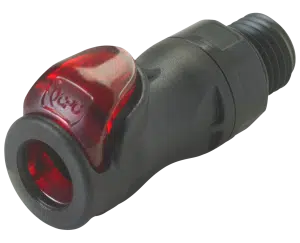
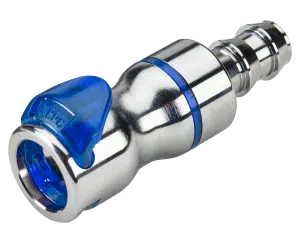
At a high level, fluids can affect polymers in two different ways: physically and chemically. The first is generally reversible while the other is not. For example, an O-ring compound in a quick disconnect might have an affinity for a certain coolant, causing the O-ring to swell, which creates connection and disconnection issues that potentially lead to leaks. Replacing the O-ring with an alternative plastic or specifying a different fluid could correct the problem.
However, in a chemical interaction, in which a plasticizer is extracted from a component such as tubing, the effects of that dissolved plasticizer on the fluid’s performance can be dramatic and are irreversible, which can be a critical issue in sensitive high-value applications.
General guidance can provide a good starting point. Table 3 provides an overview of relative compatibility between various materials and coolant options. Remember, a holistic view of the full application details is the best way to ensure that the right materials are specified. It is incumbent on system designers to test components under expected operating extremes for their applications to assess fluid and material interactions at application-specific temperatures, pressures, and other environmental conditions.
A key to successful liquid cooling design is to engage with component suppliers early. This allows for the identification of any materials that might be exposed to coolant, and any other variables that might be present so that a design solution that is optimized for the specific system requirements can be developed.
Material and Coolant Compatibility
When considering wetted components in a liquid cooling system, the following combinations are:
- A = Recommended. Little or no potential for chemical reaction or corrosion.
- B = Good options. Minor potential for chemical reaction or corrosion, with limited effect on system performance.
- F = Not recommended. Mild to severe chemical or corrosive reactions likely. May impede system performance.
